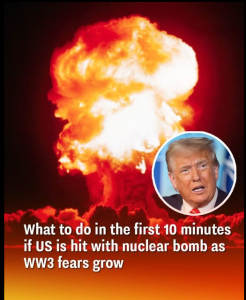
What To Do in the First 10 Minutes After a Nuclear Blast: A Step-by-Step Survival Guide Amid WW3 Fears
By: Crisis Survival Bureau | Word Count: 1000
As global tensions simmer and whispers of World War III grow louder, many are wondering what they would do in the terrifying event of a nuclear detonation. While we all hope such a moment never comes, preparing for the worst could be the difference between life and death.
If a nuclear explosion occurs near your area, the first 10 minutes are absolutely critical. Here is a detailed, step-by-step guide on what to do to protect yourself and your loved ones in those crucial moments.
0:00–0:01 Minutes — Realization and Shock
The first sign of a nuclear blast is often a blinding flash of light—brighter than the sun. It might be followed by a fireball or a rapidly growing mushroom cloud if you’re within visual range.
-
Don’t stare at the flash — It can cause permanent blindness within seconds.
-
Drop and cover immediately. If you’re outdoors and see the flash or hear the blast, lie flat on the ground and cover your head. Your instinct may be to run, but the shockwave travels faster than sound. Hitting the deck could save you from flying debris or burns.
-
If inside, get as far from windows as possible. Glass will shatter within seconds.
0:02–0:04 Minutes — Surviving the Shockwave
The shockwave from a nuclear explosion can reach out for miles. In urban areas, this could level buildings. After the initial flash, the blast wave will strike.
-
Stay down. The wave may arrive several seconds after the flash, depending on your distance.
-
Protect your ears and keep your mouth open. This can help prevent ruptured eardrums and internal pressure injuries.
-
Don’t move yet. Secondary blasts (like cars exploding or buildings collapsing) may follow the initial shockwave.
0:05–0:07 Minutes — Move Quickly to Shelter
After the shockwave, you may have only a few minutes before radioactive fallout begins to descend.
-
Seek shelter immediately. Your best options:
-
A basement or underground structure.
-
A building made of concrete or brick with minimal windows.
-
Interior rooms with no external walls (such as a bathroom or stairwell).
-
-
If you’re in a car: Get out and find a building. Vehicles offer little to no protection from radiation.
-
If you’re caught outside: Lie in a ditch or low-lying area and cover exposed skin with clothing.
0:07–0:10 Minutes — Seal Your Shelter
Fallout—radioactive ash and debris—can start falling within 10 to 15 minutes after the explosion, especially if the bomb was ground-based.
-
Close all windows and doors. Shut off fans, air conditioners, or heating systems that draw in outside air.
-
Seal gaps with duct tape, towels, or even clothing to prevent contaminated air from entering.
-
Stay low and central. Radiation is weaker the farther you are from outside walls and the higher up you are in the building. However, basements are safest due to the shielding from earth.
What You’ll Need (If Time Allows)
If you had time to prepare a “go bag” or fallout kit, now is when it becomes invaluable. Essential supplies include:
-
Battery-powered radio (for official updates)
-
Bottled water (minimum 1 gallon per person per day)
-
Non-perishable food
-
Flashlights and extra batteries
-
First-aid kit
-
Dust masks and plastic sheeting
-
Potassium iodide pills (can reduce absorption of radioactive iodine)
-
Essential medications
If you don’t have a pre-packed kit, grab these items only if it is safe to do so on your way to shelter.
Understanding Fallout: The Real Killer
The nuclear blast itself causes devastating heat, force, and light. But what comes next—radioactive fallout—is what kills the most people in the hours and days that follow.
Fallout looks like grayish-white ash or sand, and it settles over the blast zone and surrounding areas based on wind patterns.
-
Exposure can lead to radiation sickness: vomiting, burns, internal bleeding, and death.
-
Fallout is most dangerous within the first 48 hours after the explosion, when radiation levels are at their peak.
-
Staying inside for at least 24–72 hours can drastically improve your chances of survival.
Common Mistakes to Avoid in the First 10 Minutes
-
Running outside to see what happened.
Curiosity can kill. You’ll expose yourself to dangerous radiation or secondary blasts. -
Attempting to flee immediately.
Roads will be blocked, communications jammed, and fallout could begin before you’re even out of town. -
Using your phone to post or call everyone.
Phone lines may be down or overloaded. Save your battery for emergency use. -
Not covering your mouth and nose.
Fallout can be inhaled. A cloth mask, shirt, or scarf can help block particles temporarily. -
Panicking.
Panic wastes precious time. Calm, informed action is your best defense.
What Happens After the First 10 Minutes?
Once you’re sheltered and sealed off, do not leave unless you are in immediate danger (such as a collapsing structure or fire). Stay informed by:
-
Tuning in to official channels. Emergency broadcasts may direct you to evacuation zones or safe shelters.
-
Watching for signs of radiation poisoning. Symptoms like nausea, dizziness, and burns could appear within hours.
The Bigger Picture: Why Preparation Matters
As geopolitical tensions rise—with potential flashpoints in Eastern Europe, the Middle East, and the Pacific—nuclear fears are no longer relegated to Cold War fiction. A single strike could trigger a chain of events affecting millions.
But survival is possible.
Governments may not be able to respond immediately. Power, water, and communication may be down. You might be on your own for hours or even days. That’s why knowing these first 10-minute steps is so critical.
Final Words of Caution and Hope
Surviving a nuclear event is not just about having a bunker or high-tech gear. It’s about quick thinking, sound judgment, and the will to act calmly when chaos erupts.
The first 10 minutes won’t be easy. You’ll be scared. Confused. Shaken. But with knowledge and a plan, you stand a fighting chance.
Prepare today—not out of fear, but out of respect for life. Because while we cannot control world events, we can control how ready we are when the unthinkable happens.

